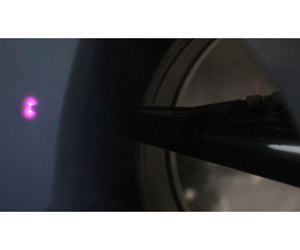Article contents
Controlled stationary/travelling cross-flow mode interaction in a Mach 6.0 boundary layer
Published online by Cambridge University Press: 30 January 2020
Abstract

Experiments were performed to further investigate a quadratic interaction between stationary and travelling cross-flow modes that was revealed in the previous experiment by Corke et al. (J. Fluid Mech., vol. 856, 2018, pp. 822–849) in the boundary layer on a sharp right-circular cone at an angle of attack at Mach 6.0. As with the previous experiment, passive discrete roughness was applied near the cone tip, just upstream of Branch I of the linear stability neutral curve for stationary cross-flow modes. The passive roughness consisted of indentations (dimples) that were evenly spaced azimuthally to excite a specific azimuthal wavenumber. A plasma actuator was located just downstream of the discrete roughness array. This was designed to produce an azimuthally uniform unsteady disturbance with a frequency that was at the centre of the band of most amplified travelling cross-flow modes. Measurements consisted of off-wall azimuthal profiles of mean and fluctuating total pressure at different axial locations. Spectra of total-pressure fluctuations verified the receptivity of the boundary layer to the unsteady excitation. This affected the azimuthal and streamwise development of the stationary cross-flow modes, with a general effect to move the transition location upstream by approximately 16 %. The quadratic interaction between the stationary and travelling cross-flow modes was further enhanced by the excitation of the travelling cross-flow mode. This was particularly evident by an enlarged band of azimuthal wavenumbers over which a significant triple phase locking existed. The significantly enlarged range of wavenumber sum and difference interactions offered a mechanism for rapid spectral broadening that could account for the hastened transition by the addition of unsteady disturbances.
- Type
- JFM Papers
- Information
- Copyright
- © The Author(s), 2020. Published by Cambridge University Press
References
- 16
- Cited by


